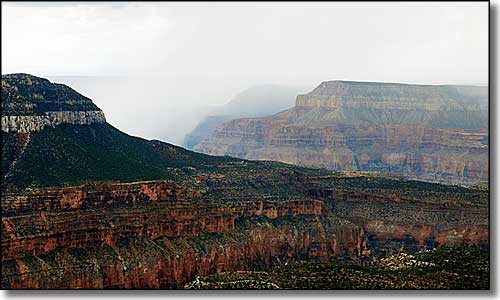
Kaibab National Forest

The Kaibab National Forest has the distinction of surrounding one of the Earth's greatest natural creations: the Grand Canyon. Both the north and south rims of the Canyon border the Forest. North of the Grand Canyon and on the west side of the Kaibab is the incredible Grand Canyon-Parashant National Monument, a million-plus-acre property of great diversity and great similarity to the Grand Canyon. North of the Grand Canyon and east of the Forest is the Paria Canyon-Vermilion Cliffs Wilderness, another spectacular area of diversity and similarity to the Grand Canyon itself. South of the Grand Canyon, the Kaibab extends across a large chunk of Arizona to the edge of the Mogollon Rim, the southern boundary of the Colorado Plateau from which all this spectacular canyon country is cut.
Elevations on the Forest range from a low of about 5,500' southwest of Williams to the summit of Kendrick Mountain (10,418'). The Kaibab is a 1.6 million-acre component of the largest contiguous Ponderosa pine forest in the United States. On the east and southeast, the Kaibab borders the Coconino National Forest. To the south it borders the Prescott National Forest. And a hike to the top of Kendrick Mountain will let you see all of this and more.
At the higher elevations of the Forest you'll find Engelmann and blue spruce, aspen, Douglas fir, Ponderosa pine and live oak. A bit lower down is the pinon-juniper woodland. Below that you'll find Gambel oak, sagebrush, bitter brush, cliffrose and the components of chaparral: mesquite, manzanita, mountain mahogany, etc. The Forest also supports elk, mule deer, pronghorn, black bear, mountain lion, bobcat, coyote, skunk, porcupine, fox, and wild turkey.
The developed campgrounds at Kaibab see more than 150,000 visitors each year. The campgrounds at Dogtown Lake, Cataract Lake, White Horse Lake and Kaibab Lake are operated under permit by Southwest Recreation. These lakes are where you go for fishing on this Forest because there's not a single stream that flows all year round. Some folks try their luck at some of the bigger tanks on the Forest, places like Perkins, Hells Canyon, Bar Cross and JD Dam.

Wilderness Areas on the Kaibab National Forest:
The Cohonina and Kayenta Anasazi peoples left quite a few archaeological ruins across this countryside. Their cultures first appeared in this area around 700 AD and then disappeared around 1150 AD. They lived mostly in stone houses and pit houses, cultivated their crops and made pottery. They were here during the time of the eruptions at Sunset Crater, just to the east.
At the southern edge of the Kaibab is the Sycamore Canyon Wilderness, a place where Sycamore Creek spent several million years cutting into the edge of the Mogollon Rim to make itself a beautiful pathway heading south to the Verde River. The Sycamore Rim Trail is a gorgeous 11-mile hike along the Rim that gives quite the taste of this spectacular area. You can also enter into the Canyon from its northern end and make the hike down through the riparian areas that line the stream for most of that 20-mile journey to the Verde.
Saddle Mountain Wilderness is on the northeast side of the Forest, sandwiched between the Marble Canyon and the edge of the Kaibab Plateau. On the south side is the Grand Canyon National Wildlife Refuge and on the north side is the Paria Canyon-Vermilion Cliffs Wilderness.
Kanab Creek Wilderness is on the northwest side of the Forest, bordered on the south by the Grand Canyon and on the west by Grand Canyon-Parashant National Monument. Kendrick Mountain is northeast of Williams and southeast of Tusayan, on the eastern edge of the Forest against the boundary with the Coconino National Forest.

